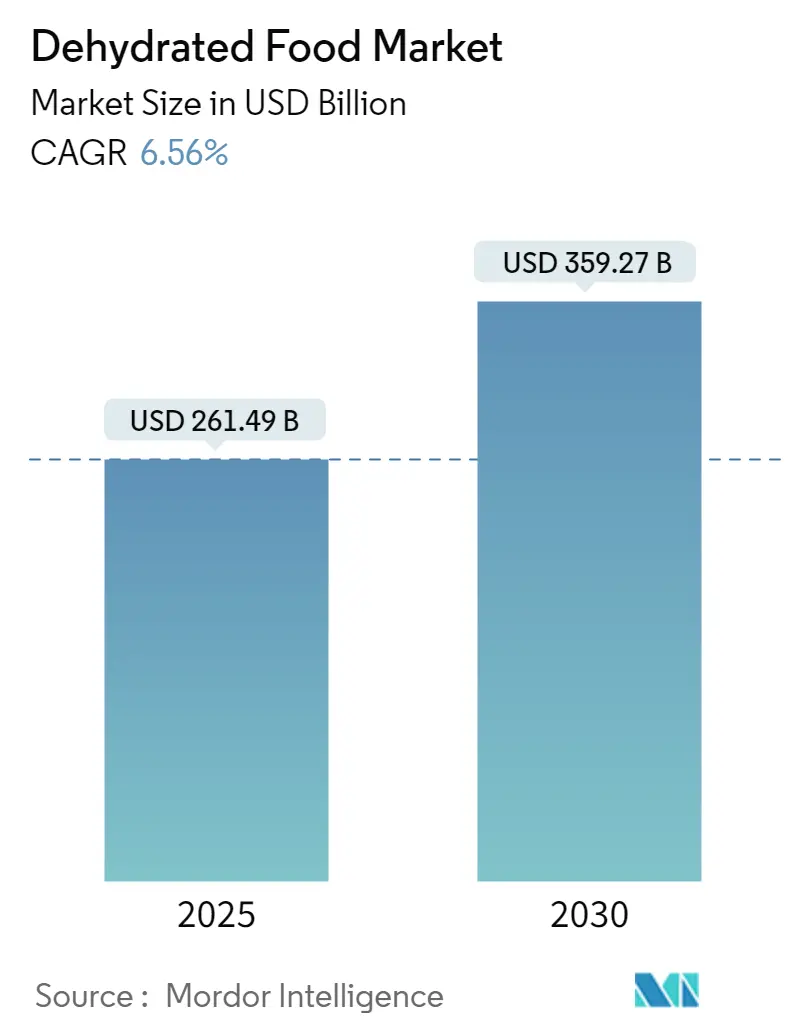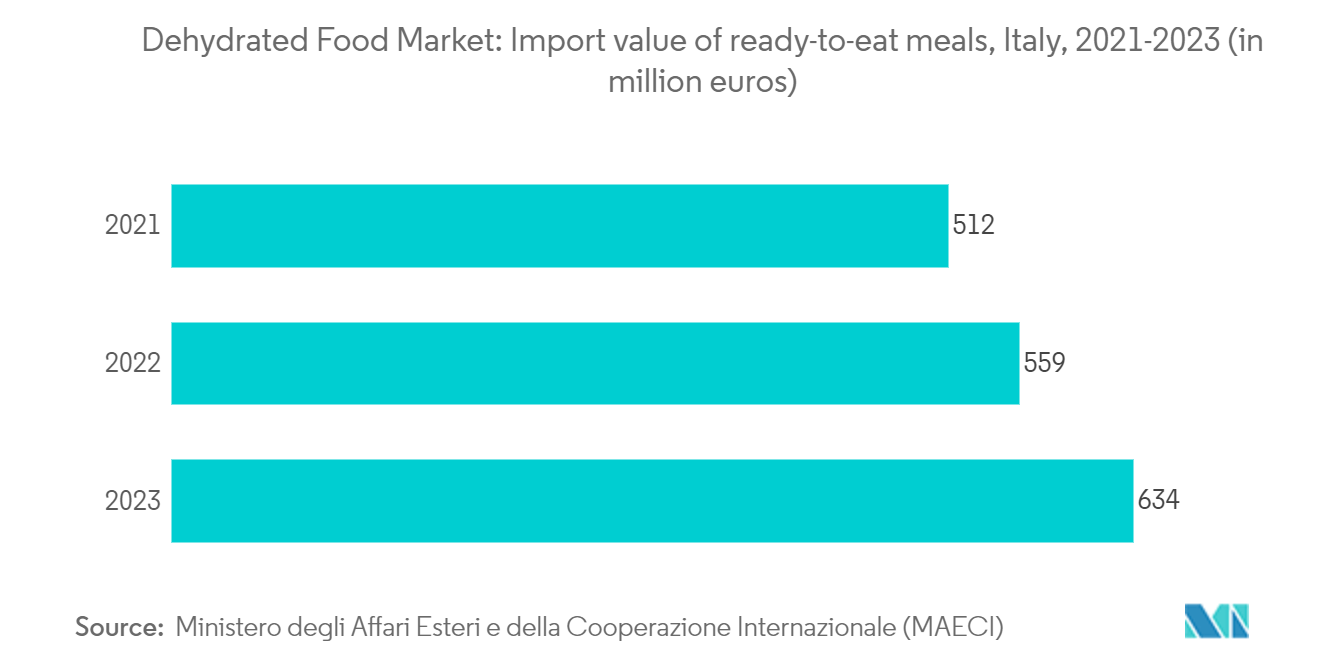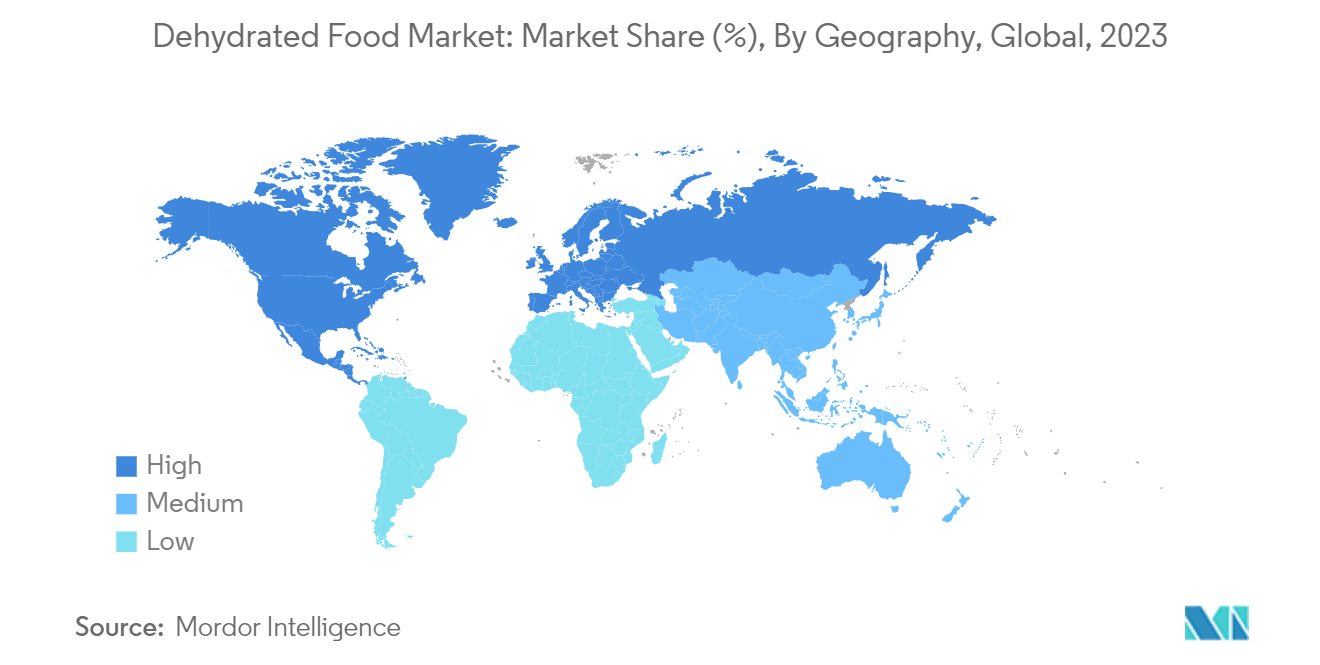Dehydrated Food Market Size

| Study Period | 2019 - 2030 |
| Market Size (2025) | USD 261.49 Billion |
| Market Size (2030) | USD 359.27 Billion |
| CAGR (2025 - 2030) | 6.56 % |
| Fastest Growing Market | Asia Pacific |
| Largest Market | Europe |
| Market Concentration | Low |
Major Players.webp)
*Disclaimer: Major Players sorted in no particular order |
Dehydrated Food Market Analysis
The Dehydrated Food Market size is estimated at USD 261.49 billion in 2025, and is expected to reach USD 359.27 billion by 2030, at a CAGR of 6.56% during the forecast period (2025-2030).
The surge in demand for dehydrated food products can be attributed to several key factors. These include heightened consumer awareness of the nutritional benefits, a preference for conveniently packaged foods, especially among busy professionals, a growing urban population with higher disposable incomes, and evolving lifestyles that favor ready-to-eat snacks. Among dehydration methods, spray-dried technology stands out for its efficiency and cost-effectiveness. Widely adopted in dairy, coffee, and flavorings, it swiftly turns liquids into powders, preserving both flavor and nutrition. Freeze-dried technology, on the other hand, is gaining traction for its ability to preserve delicate nutrients and flavors, making it ideal for heat-sensitive foods. Its integration in various products not only extends their shelf life but also enhances convenience. The market is further fueled by the growing demand for exotic fruits and vegetables. Recognizing the need for nutritious options, companies are increasingly introducing dehydrated foods. For instance, in 2024, NRGene Technologies Ltd. unveiled Supree, a FoodTech subsidiary specializing in innovative fruit and vegetable varieties. Their flagship line features semi-dried tomatoes, boasting a high nutritional value and a shelf life of up to a year.
Dehydrated Food Market Trends
Growing Demand for Freeze-dried Food Products
The surge in demand for convenient food products, driven by a desire for enhanced taste, safety, and consistency, is a key driver for the thriving freeze-dried food market. With modern lifestyles becoming increasingly fast-paced, consumers are turning to ready-to-cook and ready-to-eat options. Data from the British United Provident Association in 2022 revealed that 2 out of 5 adults in the UK opt for ready-to-eat meals. Freeze-drying, as a preservation method, stands out for its ability to preserve nutritional value, flavor, and texture, making it an attractive choice for health-conscious consumers. In response, market players are diversifying their offerings, introducing a range of healthy freeze-dried products spanning fruits, dairy, and beverages. For instance, in March 2024, Brother’s All Natural introduced infused freeze-dried fruit crisps, featuring flavors like raspberry, blueberry, and strawberry, all kosher and non-GMO.

Europe Holds a Significant Market Share
The dehydrated food market in the UK thrives on significant imports of dehydrated fruits and vegetables. In 2023, the UK imported dried vegetables worth EUR 82,975, reflecting a consumer preference for nutritious, longer-lasting ingredients. These imports cater to the growing health-conscious demographic. Additionally, the surge in demand for dehydrated fruit-based snacks, like tangy pineapple chips or air-dried pineapple pieces, underscores this trend. Notably, 70% of imported dried pineapple in 2024 is retailed as snacks, appealing to health-conscious UK shoppers.
Germany stands out as a key market for dehydrated fruit products, driven by its health-conscious consumer base. In 2023, Germany led the European continent in vegetable imports, ranked second in fruit imports, and emerged as the second-largest consumer of dried tropical fruits, following the UK. Notably, dried natural mangoes and sugar-free dried bananas have seen remarkable growth, transitioning from specialized stores to major discount retailers like Aldi and Lidl. Brands like Seeberger, Farmer's Snack, Kluth, and MorgenLand are prominent in the dried tropical fruit market.
In Italy, the growing interest in outdoor activities, including hiking and trekking, has spurred demand for portable, easy to prepare food options. In 2022, over a third of Italy's population, roughly 19.9 million individuals, participated in sports activities, as per an Italian sports activity report. Given scenic hiking trails in the Dolomites, Alps, and Apennines, dehydrated foods, from meals to snacks and ingredients like dried fruits and instant soups, perfectly cater to the needs of hikers and trekkers.

Dehydrated Food Industry Overview
The market studied is highly competitive due to the presence of global and regional players. Major players competing in the market include European Freeze Dry, Nestlé SA, Ajinomoto Co. Inc., Asahi Group Holding Ltd, and OFD Foods LLC. Global players increasingly adopt product innovation, partnerships, and expansion to meet consumer demand and stay competitive in the market. Production innovation allows companies to introduce new and improved products, while partnerships enable them to leverage each other's strengths. Expansion helps companies increase their market presence and reach a broader audience, enhancing their competitiveness.
Dehydrated Food Market Leaders
-
Nestlé SA
-
Ajinomoto Co. Inc.
-
Asahi Group Holding Ltd
-
OFD Foods LLC
-
European Freeze Dry
*Disclaimer: Major Players sorted in no particular order

Dehydrated Food Market News
- June 2024: Nestle allocated USD 29.1 million to a new technology that produces noodles with reduced fat and salt content.
- March 2024: Amano Foods launched a new specially made freeze-dried miso soup. The product is available in different variants containing veggies, seasonings, and spices.
- January 2024: GEA helped Nestlé reduce steam consumption by 75% at its new infant formula plant in Nunspeet, Netherlands. GEA equipped the milk powder line with advanced process and heat pump technology. Nestlé reported that innovative heat recovery from the spray dryer and other processes led to significant energy reduction and lower carbon emissions.
Dehydrated Food Market Report - Table of Contents
1. INTRODUCTION
1.1 Study Assumptions and Market Definition
1.2 Scope of the Study
2. RESEARCH METHODOLOGY
3. EXECUTIVE SUMMARY
4. MARKET DYNAMICS
4.1 Market Drivers
4.1.1 Consumer Demand For Convenient Food Products
4.1.2 Rise of Tourism
4.2 Market Restraints
4.2.1 High Costs Associated With Dehydration Technology
4.3 Porter's Five Force Analysis
4.3.1 Threat of New Entrants
4.3.2 Bargaining Power of Buyers/Consumers
4.3.3 Bargaining Power of Suppliers
4.3.4 Threat of Substitute Products
4.3.5 Intensity of Competitive Rivalry
5. MARKET SEGMENTATION
5.1 Product Type
5.1.1 Spray-dried
5.1.2 Freeze-dried
5.1.3 Vacuum-dried
5.1.4 Sun-dried
5.1.5 Other Types
5.2 Product
5.2.1 Dairy Products
5.2.2 Fruits and Vegetables
5.2.3 Meat and Seafood
5.2.4 Instant Coffee
5.2.5 Dehydrated Prepared Meals
5.2.6 Spices and Herbs
5.2.7 Other Product Type
5.3 By Distribution Channel
5.3.1 Hypermarket/Supermarket
5.3.2 Convenience Stores
5.3.3 Online Retail Stores
5.3.4 Other Distribution Channels
5.4 Geography
5.4.1 North America
5.4.1.1 United States
5.4.1.2 Canada
5.4.1.3 Mexico
5.4.1.4 Rest of North America
5.4.2 Europe
5.4.2.1 United Kingdom
5.4.2.2 Germany
5.4.2.3 France
5.4.2.4 Netherland
5.4.2.5 Italy
5.4.2.6 Spain
5.4.2.7 Rest of Europe
5.4.3 Asia Pacific
5.4.3.1 India
5.4.3.2 China
5.4.3.3 Japan
5.4.3.4 Australia
5.4.3.5 Rest of Asia-Pacific
5.4.4 South America
5.4.4.1 Brazil
5.4.4.2 Argentina
5.4.4.3 Rest of South America
5.4.5 Middle East & Africa
5.4.5.1 South Africa
5.4.5.2 Saudi Arabia
5.4.5.3 Rest of Middle East & Africa
6. COMPETITIVE LANDSCAPE
6.1 Most Adopted Strategies
6.2 Market Share Analysis
6.3 Company Profiles
6.3.1 European Freeze Dry
6.3.2 Ajinomoto Co. Inc.
6.3.3 Nutristore Canada
6.3.4 Augason Farms
6.3.5 Nestlé SA
6.3.6 Asahi Group Holding Ltd
6.3.7 Harmony House Foods Inc.
6.3.8 LYOFOOD Sp. z.o.o.
6.3.9 Thrive Life LLC
6.3.10 OFD Foods LLC
- *List Not Exhaustive
7. MARKET OPPORTUNITIES AND FUTURE TRENDS
Dehydrated Food Industry Segmentation
Dehydrated food is food that undergoes a drying process to eliminate most of its natural moisture, serving to preserve it. This preservation method mitigates common issues like mold and fermentation that fresh foods are prone to.
The market studied is segmented by product type, product, distribution channel, and geography. By product type, the market is segmented into spray-dried, freeze-dried, vacuum-dried, sun-dried, and others. Based on product, the market is segmented into dairy products, fruits and vegetables, meat and seafood, instant coffee, dehydrated prepared meals, spices and herbs, and others. By distribution channel, the market is segmented into hypermarkets/supermarkets, convenience stores, online retail stores, and others. On the geographical front, the market is studied for different countries under each region, namely North America, Europe, Asia-Pacific, South America, and the Rest of the Middle East & Africa.
For each segment, the market sizing and forecasts have been done based on value (in USD).
| Product Type | |
| Spray-dried | |
| Freeze-dried | |
| Vacuum-dried | |
| Sun-dried | |
| Other Types |
| Product | |
| Dairy Products | |
| Fruits and Vegetables | |
| Meat and Seafood | |
| Instant Coffee | |
| Dehydrated Prepared Meals | |
| Spices and Herbs | |
| Other Product Type |
| By Distribution Channel | |
| Hypermarket/Supermarket | |
| Convenience Stores | |
| Online Retail Stores | |
| Other Distribution Channels |
| Geography | |||||||||
| |||||||||
| |||||||||
| |||||||||
| |||||||||
|
Dehydrated Food Market Research FAQs
How big is the Dehydrated Food Market?
The Dehydrated Food Market size is expected to reach USD 261.49 billion in 2025 and grow at a CAGR of 6.56% to reach USD 359.27 billion by 2030.
What is the current Dehydrated Food Market size?
In 2025, the Dehydrated Food Market size is expected to reach USD 261.49 billion.
Who are the key players in Dehydrated Food Market?
Nestlé SA, Ajinomoto Co. Inc., Asahi Group Holding Ltd, OFD Foods LLC and European Freeze Dry are the major companies operating in the Dehydrated Food Market.
Which is the fastest growing region in Dehydrated Food Market?
Asia Pacific is estimated to grow at the highest CAGR over the forecast period (2025-2030).
Which region has the biggest share in Dehydrated Food Market?
In 2025, the Europe accounts for the largest market share in Dehydrated Food Market.
What years does this Dehydrated Food Market cover, and what was the market size in 2024?
In 2024, the Dehydrated Food Market size was estimated at USD 244.34 billion. The report covers the Dehydrated Food Market historical market size for years: 2019, 2020, 2021, 2022, 2023 and 2024. The report also forecasts the Dehydrated Food Market size for years: 2025, 2026, 2027, 2028, 2029 and 2030.
Dehydrated Food Industry Report
Statistics for the 2025 Dehydrated Food market share, size and revenue growth rate, created by Mordor Intelligence™ Industry Reports. Dehydrated Food analysis includes a market forecast outlook for 2025 to 2030 and historical overview. Get a sample of this industry analysis as a free report PDF download.



